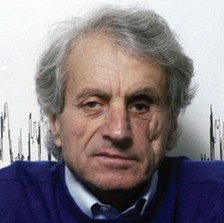
Iannis Xenakis (1922–2001, Greece/France), although born in Romania, at the age of five, settled with his family in Greece. In 1947, he began his studies at the Athens Polytechnic Institute, where he was also part of an anti-fascist and later anti-English underground movement. Because of these activities he was sentenced to death in 1947. The same year he fled to France where he started working as an architect, an assistant to Le Corbusier until 1960. During that time, he realised, among other things, the Couvent de La Tourette (1955), and the Philips Pavilion at Expo in Brussels (1958). He began studying music in 1948 with Arthur Honegger, Nadia Boulanger, and Darius Milhaud. In 1949–1950 he studied with Olivier Massiaen, who encouraged him to develop his creative musical ideas. Xenakis’s first success in music was the première of Metastasis at the Donaueschingen Festival in 1955. At a time when serialism was the dominant technique, Xenakis ventured on a new path, owing to his knowledge of design and engineering (he introduced probability theory into his composing technique) and to his interest in complex acoustic phenomena. In his large oeuvre, an important place belongs to electro-acoustic and multimedia works that include sound, light, movement, and architecture. In the domain of computer music, he was the pioneer of algorithmic composition. He devised a system of digital synthesis and random variation of waveforms. In 1965, Xenakis founded the Centre d’études de mathématiques et automatique musicales (CEMAMu) in Paris. He was a professor of music at several universities: Center for Mathematical Automated Music (CMAM), which he also founded, at Indiana University in Bloomington (1967–1972), Sorbonne University in Paris (1972–1989), and the City University of London (1975). Xenakis received many awards and titles such as the Manos Hadjidakis Prize in Athens (1963), Nippon Academy Award (1971), Officier de l’Ordre National du Mérité in Paris (1985).
Theraps (1975–76) for double bass was written for eminent Italian soloist Fernando Grillo, who performed it in March 1976 at the Festival de Royan. The director of the contemporary music festival in Royan was so impressed with his instrumental creativity that he commissioned a whole series of double-bass pieces to be premièred by Grillo. These included pieces such as Iannis Xenakis’s Theraps and works by Christian Wolff and Klaus Huber. In the early stages, Grillo and Xenakis explored new techniques of sound production and expression on the instrument. In the programme notes, Xenakis suggested that the performer ‘might also accelerate the movement (metronomic indications) and exaggerate the dynamic range pp to fff everywhere in order to obtain both a sensitive fineness and a savageness of the piece’.
Theraps oscillates between two contrasting areas: where the music is in a constant state of flux (glissandi) and pairs of static natural harmonics. As the title suggests, Xenakis deals with the problem of performance practice, which implies not only ‘learning the notes’, but also ‘exercising the mind’: ‘I do take into account the physical limitations of performers. […] In order for the artist to master the technical requirements he has to master himself. Technique is not only a question of muscles, but also of nerves’. The work is based on Xenakis’s Random Walk, Brownian Movement, theory which is related to stochastic principles.


